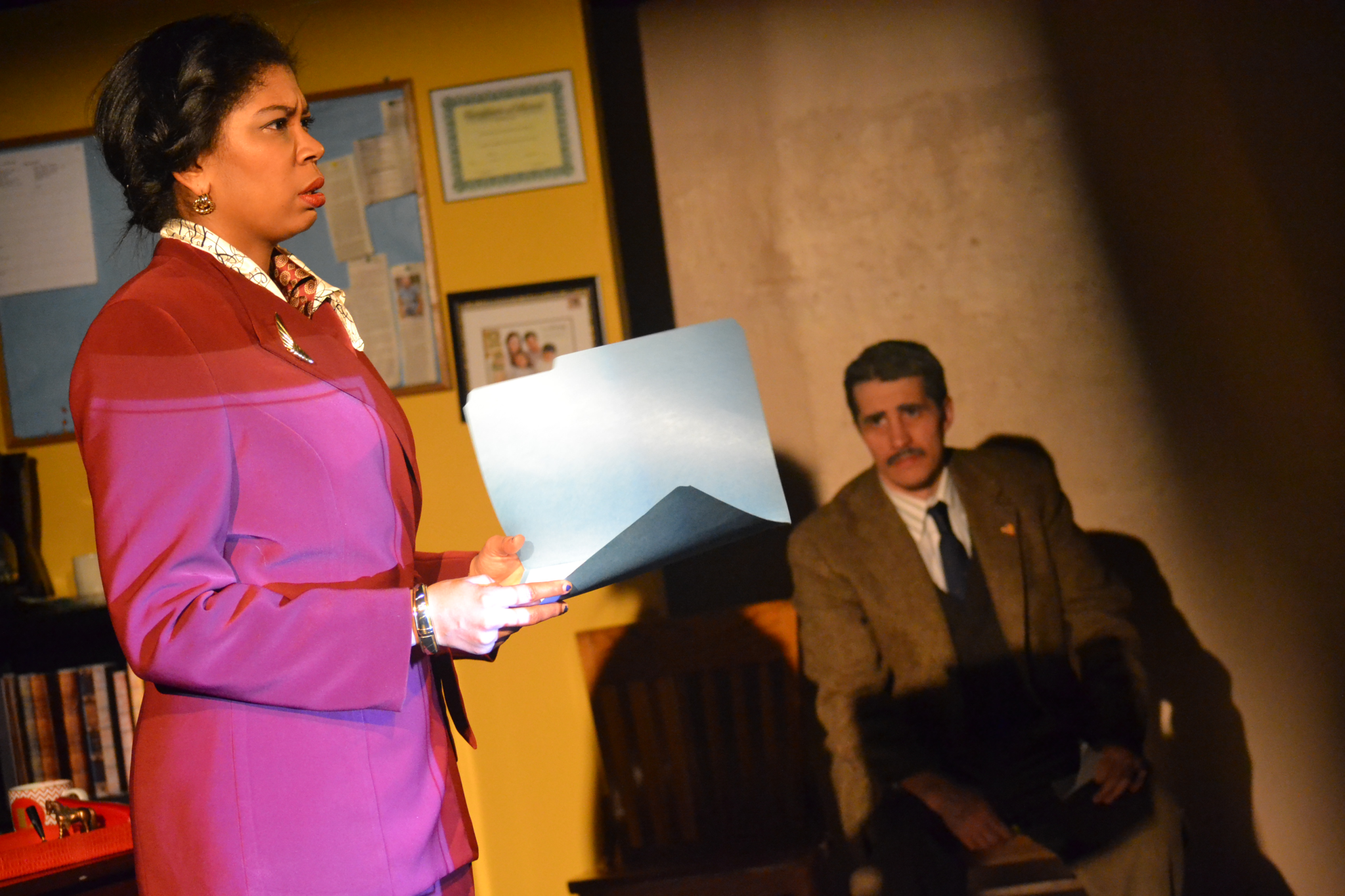The two main characters of Nikkole Salter’s Lines in the Dust, Denitra (Elaine C. Bell) and Beverly (Quenna Lené Barrett), represent diverging potentials from the same source and opposing ideologies of how to achieve success. Both grow up in a poor area of Newark, New Jersey, but from there chance shifts them apart. Beverly attends a mostly white boarding school on scholarship before going on to Princeton and—as she mentions consistently, like a refrain—earning “three degrees.” Meanwhile, Denitra lingers in a local public school, convinced she is going on to Harvard. Her academic performance is high in comparison to her peers, but to her surprise she falters when it comes to standardized tests; she ends up attending community college, where she is placed in several remedial classes.
Through the microcosmic lens of these women’s divergent experiences, the play’s Chicago premiere at eta Creative Arts tackles questions of justice: can success be attributed to actual hard work or merely to circumstance? How can we claim this country to be a meritocracy when so much prosperity stems from privilege? As Denitra claims, “Opportunity is not just about merit—it’s about positioning.”
“We are lovely people,” Beverly insists, when she and Denitra are rebuffed from an open house in the affluent and insular community of Millburn. But Beverly thinks Denitra is a lawyer with a similar background as herself, a persona Denitra is adopting only so she can send her daughter to a school in the Millburn school district, of which Beverly is the principal. Salter makes the intriguing choice of making Noelle, Denitra’s daughter, the “ghost” of the play—the character who’s never seen but serves as the focal point of most conversations. Because of this, she is more symbolic than tangible. She represents the many children in her situation: hardworking and ready to learn, but denied the proper opportunities in their own school districts.
For a play with only three characters—the other being the intrusive and overly eager investigator Mike DiMaggio (Benjamin Todd)—the story is full of such intricacies, perhaps overly so. The plot takes several unexpected dips at various times, resulting in an array of false endings. The actual ending peters out, leaving no sense of finality. This effect may be Salter’s intention, a statement that these problems persist without resolution, but it comes across as running out of ideas for a more narratively satisfying conclusion.
Therein lies the ultimate conflict in Lines in the Dust: with so much focused on what it has to say, it often loses sight of itself as a play. Denitra and Beverly often seem to act as mouthpieces for their respective points of view, delving into diatribes about their outlooks on fairness and the purpose of education. Bell embodies the weariness of downtrodden Denitra, and Barrett has the proper comportment of Beverly, but it would be difficult for the actors not to struggle with these long speeches, which are not yet natural in their mouths. While their perspectives are interesting and the tension palpable, we often lose sight of who these characters are beyond their relation to the access of proper education in America.
Likewise, the character of DiMaggio adds an extra layer of complexity and a new voice to the din, one that feels somewhat out of place and unnecessary. DiMaggio stumbles into the dialogue with his awkward gait and inopportune jokes. He is adamant on maintaining the standards of a community by not letting the outside (i.e. children from poor school districts—ostensibly bringing with them a violent culture) in. The play hints that this resentment comes from his growing up in an older, different Newark, one inhabited by Italian immigrants rather than the gangs he claims currently run rampant.
Though DiMaggio is a character of hidden depth, despite his hackneyed sense of humor—somewhat more interesting, unexpectedly, than either of the female leads—he prevents Denitra and Beverly from being more fully realized, the development of his background and motivations taking up space that could have been spent fleshing out the women’s personalities. Much of his voice seems to be a more prejudiced version of Beverly’s: the ideal that people can achieve success through hard work, despite lack of inherent opportunity. While his voice would be welcomed in further expanding this discussion, it comes across as too comically antagonistic to warrant any respect as a valuable opinion. He is set so much in opposition to the main characters, that one cannot help but write his views off as mere intolerance and ingrained conservatism. Nevertheless, his motivations—the desire to cling on to an old way of life, even at the expense of others—are compelling. Even if the interactions leave things to be desired, all of the characters still brim with potential and passionate ambitions.
Lines in the Dust is the last in a sequence eta Creative Arts has held on Salter’s work. Earlier this season they staged her play Repairing a Nation and a reading of Carnaval. Like Lines in the Dust, Salter’s other work tends to tackle resounding social issues about blackness in America and the intertwining of race and socioeconomics. Her acute thoughts are tangible in these plays, but in Lines, the pursuit of big ideas comes at the expense of making characters wooden and dialogue stilted. While Lines in the Dust is admirable in its scrutiny of the politics of education, it struggles as a piece of theater.

